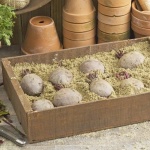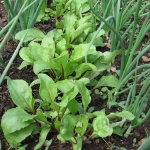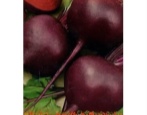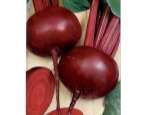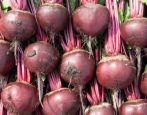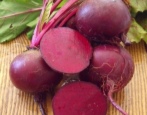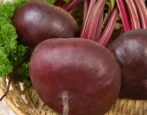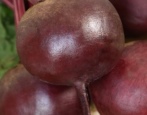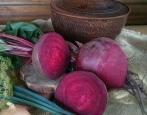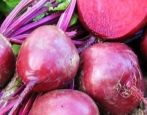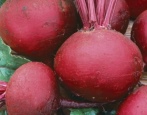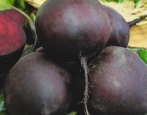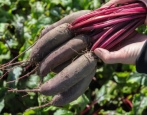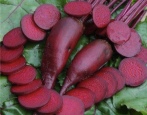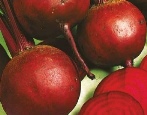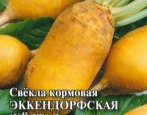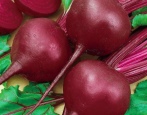
- Authors: Kachainik V.G., Gulkin M.N.
- Year of approval: 2021
- Leaf rosette shape: semi-upright
- Leaves: broadly oval, medium intensity green veins with red color, medium bubbly, medium waviness of the edge
- Petiole: bottom side red
- The form: rounded
- Weight, g: 253-300
- Cork head: the average
- Pulp color : deep dark red
- Ringiness: without rings
The new variety of beets, Red Ball, has managed to acquire many admirers among summer residents. The compact size of the root vegetables in it are complemented by excellent taste, the brightly colored pulp does not lose color during processing. The prospects of this variety in the commercial sphere are also assessed as high.
Breeding history
The red ball was officially approved for use in 2021. Beets have been on variety trials since 2017. The applicant and originator is Agrofirma Aelita LLC. V.G. Kachainik and M.N. Gulkin are indicated as authors.
Description of the variety
The red ball belongs to table varieties of beets with a yield of marketable fruits up to 89-97%. Its distinctive characteristics include good yield, stable, calibrated sizes of root crops, and general unpretentiousness. Fast ripening is also considered an advantage - harvesting begins in July. Sowing before winter is possible, in this case, you can expect seedlings earlier, and you will be able to get the harvest faster.
Characteristics of the appearance of the plant and root crops
The plant has semi-erect rosettes with petioles painted red underneath. Leaves are green, broadly oval, with scarlet veins. Slightly wavy at the edges. Plates are medium bubble, relief.
Root crops are rounded, medium in size, weighing 253-300 grams. The surface of the skin is smooth, colored red-violet, the corking of the head is average. The pulp is rich, dark red, rather dense.
Purpose and taste of tubers
A variety of universal use. Beets are used for culinary processing, for canning, and are used fresh. Stored for a long time in winter. The taste of the Red Ball is rated as good and excellent. The pulp of the root vegetable is juicy, tender, without rings.
Maturation
The variety is early, 70-90 days pass from germination to harvest.
Yield
Average collection rates are 482-524 kg / ha. From 1 m2, you can get up to 6 kg of fruit.
Growing regions
This beet variety has been zoned for cultivation in the Central, West Siberian and Volgo-Vyatka regions.
Growing and caring
Beets of this variety are best placed in a sunny place. Sowing is carried out directly into the ground, from 10 to 20 May. The optimal planting pattern is 30x10 cm. The main care of the plants consists in periodic loosening, regular watering, and fertilization. The red ball reacts well to feeding with wood ash, it also protects it from pest attacks, potash mixtures will also be useful.
Watering is organized as needed, during periods of drought, on average, once every 10 days. Moisturization is especially important at the stage of seed germination, as well as at the stage of volume and weight gain by root crops.
As it grows, the Red Ball is thinned out twice. The first time when 2 pairs of true leaves appear on the plants. The second stage falls on the period when root crops reach a diameter of 20-30 mm.

Beetroot tolerates cold snaps, therefore it is widely grown in the open field. When planting beets, you need to correctly determine the sowing time, choose a suitable place, prepare the beds, and do pre-sowing seed treatment.
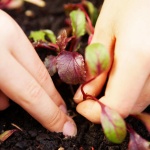
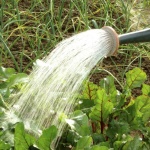
Soil requirements
The soil for planting this variety of beets should be nutritious, but not too dense. Loam, sandy loam, fertile garden soil or black soil are suitable. It is important that the groundwater does not run too close to the surface. The acidity should be neutral or close to this.
Required climatic conditions
The variety is cold-resistant and drought-resistant. It adapts well to different climatic conditions. It tolerates light shading normally.
Disease and pest resistance
The red ball is resistant to stalking. Minimally affected by diseases and pests.

Review overview
Delicious, sweet, not giving a characteristic earthy taste when cooking, the Red Ball beet has managed to win the hearts of many summer residents. It is praised not only for its culinary merit. Root crops are one-dimensional, suitable for sale, due to their dense skin, they are successfully stored until spring, which is quite unusual for early varieties. The assessment of seed germination is also high, they practically do not give gaps in the beds in the rows.
Cons are also noticed. For example, in the references to summer residents, there is information about a misgrading of seeds, when completely different root crops grow in the garden instead of the Red Ball. And also it is worth paying attention to the need for strict adherence to watering standards, otherwise the skin may become coarse.
